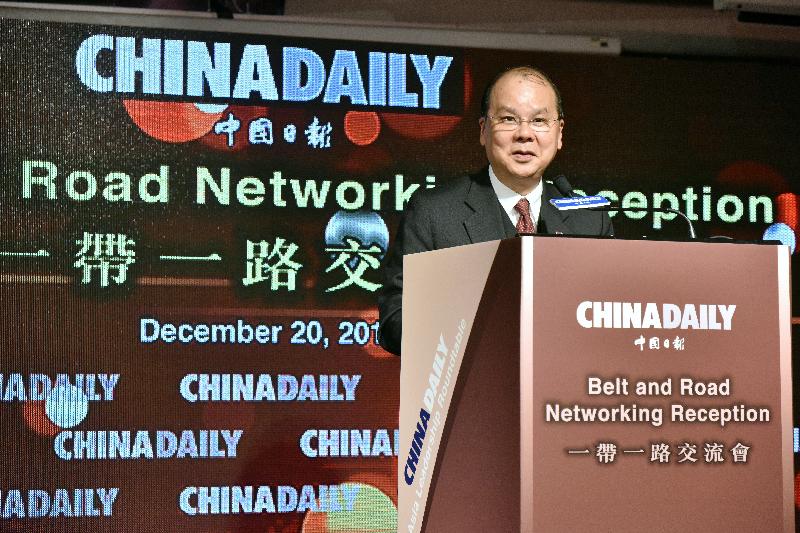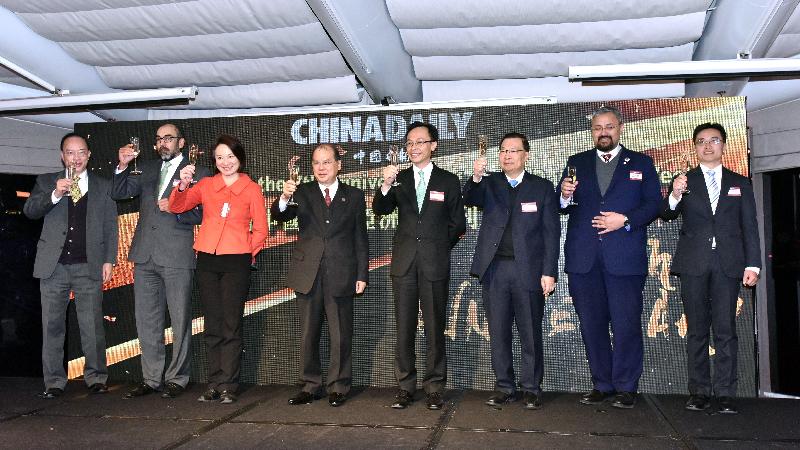Speech by CS at China Daily Belt and Road Networking Reception (English only) (with photos/video)
******************************************************************************************
Mr Zhou Li (Publisher and Editor-in-Chief of China Daily Asia Pacific), Ms Ida Song (Deputy Editor-in-Chief of China Daily Asia Pacific), Mr Joseph Li (Editor of China Daily Asia Pacific), distinguished guests, ladies and gentlemen, consuls general,
It gives me great pleasure to join you all tonight to celebrate this festive season of the year. As suggested by our cordial host, the China Daily, I am going to make the best of tonight's joyous gathering by sharing with you how Hong Kong will capitalise on the opportunities arising from the unprecedented Belt and Road Initiative and the Guangdong-Hong Kong-Macao Bay Area development through major investments in mega infrastructural cross-boundary projects.
Hong Kong is often described as having “the best of both worlds” under the principle of “one country, two systems”. Under “one country”, we receive trade access, preferential treatment and investment facilitation. Under “two systems”, we enjoy the autonomy to maintain our way of life and rule of law here. That is why Hong Kong has all along played an important role in linking the Mainland with other parts of the world, as well as serving as the gateway for overseas businesses to enter China and Asia for that matter.
While our economy has been performing well over the years, we are facing fierce competition from other economies - and the recent rise of protectionism in some economies. To meet these challenges, the current-term Government of Hong Kong is determined to develop Hong Kong into a high-value-added and diversified economy, besides strengthening our existing pillar industries. This embraces the development of new economic sectors such as innovation and technology industry, and creative industries, which will capitalise on the two mammoth national strategies I have just mentioned. The Belt and Road Initiative covers more than 60 countries and 4.4 billion people that account for over 30 per cent of global economic value, while the Bay Area represents some 66 million people that generated a combined gross domestic product of US$1.36 trillion in 2016.
We attach great importance to both the Belt and Road Initiative and the Bay Area development project, for they will be the key engines for Hong Kong’s continuous growth.
Witnessed by President Xi Jinping on July 1 this year, our Chief Executive, Mrs Carrie Lam, signed the “Framework Agreement on Deepening Guangdong-Hong Kong-Macao Cooperation in the Development of the Bay Area” with the National Development and Reform Commission, Guangdong Province and the Macao Special Administrative Region to jointly kick off the Bay Area development.
Last week, another important document was signed with regard to the Belt and Road Initiative, namely the “Arrangement between the National Development and Reform Commission and the Government of the Hong Kong Special Administrative Region for Advancing Hong Kong’s Full Participation in and Contribution to the Belt and Road Initiative” in Beijing.
The Arrangement will allow us to give full play to our unique advantages under “one country, two systems” to contribute to the country, while at the same time seize those opportunities brought by the Initiative to provide new impetus for our economic growth. The relevant measures will help reinforce and elevate Hong Kong’s position as international financial, transport and trade centres, promote partnership between Mainland and Hong Kong enterprises, spawn the demand for Hong Kong’s professional services and present our home-grown talents with promising prospects, thus enhancing the upward mobility of our younger generations.
Well developed infrastructure is a critical factor enabling Hong Kong to capture opportunities arising from the Belt and Road Initiative and the Bay Area development to sustain our economic growth and strength. Enhancing Hong Kong’s connectivity with the Mainland will boost exchanges between Hong Kong and major Mainland cities and foster the development of complementary advantages.
Not only will our pillar industries like financial services and trading and professional services benefit, but some emerging sectors like innovation and technology, legal and dispute resolution services, creative industries, medical and healthcare services, as well as higher education will also benefit from tapping the rich resources of land, labour, capital, and research and development capability on the Mainland.
Three strategic facilities connecting Hong Kong and the Mainland will open in the coming year and half. They are the Hong Kong-Zhuhai-Macao Bridge, the Hong Kong Section of the Guangzhou-Shenzhen-Hong Kong Express Rail Link, and the Liantang/Heung Yuen Wai Boundary Control Point.
First, the Hong Kong-Zhuhai-Macao Bridge, which will be ready for commissioning in the very near future, is a major infrastructural project to provide direct land transport connection between Hong Kong, Zhuhai and Macao. The project consists of two parts, namely the Main Bridge, and the link roads and boundary crossing facilities of the three sides. The 29.6-kilometre Main Bridge, including 6.7 kilometres of underwater tunnel, will be the longest bridge-cum-tunnel sea crossing in the whole world.
As a major cross-boundary project, the Bridge is unprecedented in terms of shape and scope, in terms of scale and complexity. It is strategically important as well. Its commissioning will benefit various sectors in Hong Kong including tourism, commerce and logistics. It will also facilitate the further economic development of Hong Kong, Macao and the western Pearl River Delta as a whole by significantly lowering transport costs and time for travellers and goods on the road. The journey time between the Kwai Chung Container Terminal and Zhuhai will be reduced from the existing 3.5 hours to about 75 minutes, while the journey time between Hong Kong International Airport and Zhuhai will be substantially reduced from four hours now to just 45 minutes in future.
The Bridge will also strengthen Hong Kong’s linkage with other parts of the Pearl River Delta as well as the wider Bay Area. The Western Pearl River Delta will fall within a reachable three-hour commuting radius of Hong Kong, enhancing the city’s position as a trade and logistics hub, especially in air and sea cargo throughput, for the western Pearl River Delta, western Guangdong and Guangxi. We can expect a faster economic integration of Hong Kong and other cities not only within the Bay Area, but also in neighbouring provinces.
Next, let me tell you more about the 26-kilometre Hong Kong Section of the Guangzhou-Shenzhen-Hong Kong Express Rail Link (XRL), due to open in the third quarter of 2018. The new railway will connect Hong Kong to key Pearl River Delta cities and the 22 000-kilometre national high-speed rail network on the Mainland, bringing Hong Kong closer to opportunities in cities within the Bay Area and countries along the Belt and Road.
The XRL passengers will be able to travel at ease from our West Kowloon terminus to major hub cities on the Mainland directly. This will no doubt consolidate Hong Kong’s position as a regional transport hub and create enormous economic and social benefits. Compared with the existing Intercity Through Train service, the XRL will take only about 14 minutes to reach Futian in Shenzhen, and will reduce travel time to Guangzhou from two hours to about 48 minutes, to Zhuhai from four hours to only 45 minutes, to Shanghai from 19 hours to eight hours, and to Beijing from 24 hours to just about nine hours. The convenience and connectivity offered by the XRL will bring significant and long-term benefits to tourism, and meetings, incentives, conferences and exhibitions sectors, as well as retail, catering and professional services.
Guangdong is our largest and most important partner in the Bay Area development. We share the Guangdong border with Shenzhen and have already opened six land boundary control points (BCP) with this bustling city. Now a seventh BCP is coming up very shortly. The Liantang/Heung Yuen Wai BCP will be an important eastern corridor for over 600 000 daily commuters between Hong Kong and Shenzhen, and many others travelling further afield to Shantou, Shanwei, Chaozhou and Jieyang by taking the Shenzhen-Shantou Expressway, or Huizhou and Jiangxi by the Shenzhen-Huizhou Expressway.
This new BCP will be complemented by the 11-kilometre Liantang/Heung Yuen Wai link, including the 4.8-kilometre Lung Shan Tunnel, to connect with the Fanling Highway. When the Liantang/Heung Yuen Wai BCP comes into operation next year, travelling between Hong Kong and eastern Guangdong will be much faster and far more convenient. This will provide a broader platform for Hong Kong-Guangdong co-operation. For example, the travelling time from Tai Po on the Hong Kong side to Longgang on the Shenzhen side will be cut from 53 minutes to 31 minutes, saving 21 minutes in total.
Ladies and gentlemen, Hong Kong will have a lot to offer to the Belt and Road Initiative and the Bay Area development. Our strategic location at the Mainland’s doorstep, our level-playing field for all businesses, our favourable and predictable investment environment, our simple and low tax system, our superb infrastructure and free flow of capital and information are an unrivalled package that has enabled Hong Kong to act as a “key link” for multinational companies to enter the Mainland market and as a springboard for Chinese companies to “go global”.
We can also help advance the Bay Area as an innovation centre for the Belt and Road Initiative. Hong Kong has established extensive international market networks that can connect the Bay Area with global markets. Besides, Hong Kong is well versed in international technological trends and technical standards, and offers an enormous base of highly skilled workers, supported by many well-respected tertiary institutions.
With our unique advantages as an international financial and trading centre, a global offshore Renminbi business hub and an international asset management centre, Hong Kong is well placed to meet the rising demand for fund-raising and financial management services for Chinese companies to take part in Belt and Road projects. Our professional services are renowned for high standards and familiarity with international practices. We can help companies from the Mainland explore the Belt and Road markets by offering a wide range of services, such as consulting, legal and arbitration, financing, insurance, project management and construction.
Ladies and gentlemen, Hong Kong is therefore best positioned within the Bay Area to play a key role in turning the vision of the Belt and Road Initiative into real business opportunities. All these opportunities will translate the Belt and Road Initiative and the Bay Area development into tangible benefits for enterprises and professionals of Hong Kong, the Mainland and the world.
On this note, I wish all of you a very merry Christmas and a prosperous, healthy, harmonious and happy new year. And of course, thank you very much China Daily for organising this very innovative and meaningful theme connecting under the Belt and Road Initiative. Thank you very much again.
Ends/Wednesday, December 20, 2017
Issued at HKT 19:58
Issued at HKT 19:58
NNNN




